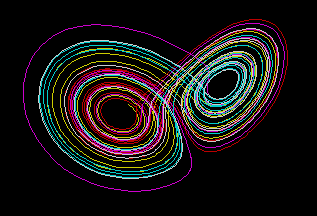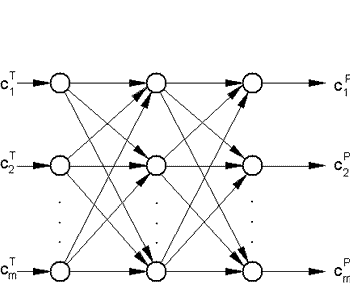


Chaos is common is nature, it can be found, for example, in chemical reactions, optics (lasers), electronic circuits, fluid dynamics (heat convection) etc. Many natural phenomena can also be characterized as being chaotic, such as the weather, solar activity and many living organism systems, such as the nervous system.
Does chaos has a function in the brain? In the following paragraphs we will make an effort to introduce the reader to these two phenomena and how they relate to each other. Indeed, a simple answer to complex issues like the present one is often misleading. So we try to be careful.
One the most important properties of chaotic systems is also their strong dependence on initial conditions. A single drop of rain running down a window pane is a good example of a chaotic system. Every drop follows a different path, and there are many initial conditions, such as its size and position, the conditions of the glass, etc., that will influence its path. Other examples are provided by the format of the flame in a candle, the size and direction of bubbles forming in a boiling liquid, etc. Watch them for a while and you will be fascinated by the seemingly unpredictability of its weird behavior.
Due to their critical dependence on the initial conditions and due to the fact that, in general, initial conditions are never known perfectly, even when we try to control them, these systems are intrinsically unpredictable. Like in the example of the raindrop, above, any chaotic phenomenon can be described in terms of its trajectory, i.e., the path its many variables tend to follow as it evolves along time. In such a system, the trajectories emerging even from very close initial conditions diverge exponentially in the course of time, for every instance or repetition of the phenomenon, so the distance among the trajectories (the difference between suceeding trajectories) also grows in time, This is the basis of the chaotic mathematical model.
However, upon studying more closely some
of these chaotic systems, scientists made a startling discovery. A chaotic
system often alternates in a seemingly random way, but if we depict its
trajectories in a suitable graphical way, we notice that the repetitions
tend to cluster in definite areas (or groups of behaviors) of the phase-space.
Phase space can be depicted by a graph in two dimensions, showing two variables
of the phenomenon. The areas where the trajectory of the system seems to
"concentrate" are known as chaotic attractors, and are often called
"wings" because an early model used in the discovery of chaos theory (the
Lorenz attractor) had two such areas that when graphically represented
resembled butterfly wings (see the illustration below).

Image
of the trajectories of a random phenomenon
forming
a strange attractor in the form of butterfly wings.
 The
fundamental unit of the brain is termed a neuron - this is just the scientific
term for a single brain cell. A neuron communicates to other neurons via
electrical impulses, also called potentials, and chemical secretions called
neurotransmitters, whose effect is not perfectly understood. Electrical
input to one neuron comes from many others, each having a specific amount
of influence, or weight, on the neuron.
The
fundamental unit of the brain is termed a neuron - this is just the scientific
term for a single brain cell. A neuron communicates to other neurons via
electrical impulses, also called potentials, and chemical secretions called
neurotransmitters, whose effect is not perfectly understood. Electrical
input to one neuron comes from many others, each having a specific amount
of influence, or weight, on the neuron.
When neuronal networks are activated, they produce a noticeable change in voltage potential, which can be captured by a special apparatus called an electroencephalograph (EEG). These changes appear as wriggling lines along the time axis in a typical EEG record.

A
typical EEG recording showing the apparently
unpredictive
fluctuation of voltage
EEG data are very important for many branches of the neurosciences, and, in fact, many sophisticated experiments in cognitive science have shown that EEG and evoked potentials are strongly correlated with specific cognitive tasks. It also serves to diagnose specific diseases, such as epilepsy.

A
three-dimensional neuron attractor
Picture
by Diek Wheeler
For example, Freeman and colleagues have developed mathematical models for EEG signals generated by the olfactory system in rabbits. These models exhibit most of the important dynamical features observed in the EEG from microelectrode recordings in the rabbit olfactory bulb, including transitions to states reminiscent of epileptic seizures.
These investigators have suggested that the learning and recognition of novel odors, as well as the recall of familiar odors can be explained through the chaotic dynamics of the olfactory cortex's electrical activity. It should be mentioned that there is debate among workers in this field on question of whether chaos is desirable or not for the brain to function properly.
Three-dimensional
phase-space diagram of an EEG
Click
on the image to see it in a bigger version.
Picture
by Krishna Nayak, Florida State University, USA
The way the brain uses chaos to ensure continual access to previously learned patterns is to develop these wings for different learned inputs. According to researchers, the background chaotic activity enables the system to jump rapidly into one of these wings when presented with the appropriate input. "The transition back and forth between the wings or between the central part and one wing stands for phase transition in the sense of physics and for pattern recognition in the sense of neural networks" (Freeman 1990).
For example, in the olfactory bulb, on inhalation a transition occurs from low level chaos to a trajectory, which in the case of a familiar odor will settle in one of several periodic orbit. But in the case of a new odor, will avoid existing periodic attractors, haunting chaotically until a new periodic attractor is established over time-forming both a familiarized response and a new one. Inhalation thus causes a bifurcation in the dynamics of one of many periodic orbits for each learned odor, embedded in a chaotic regime [Skarda et al. 1987].
Two of the most promising approaches will be reported here.
1. Constructing model of small number of interconnected neurons: Such models can mimic at least some aspects of the brain functioning. This constitutes the hot branch of artificial neural network (ANN). Such a system can be mathematically described by using equations (generally differential or difference equations) and its behaviour is studied in conjunction to observed facts.

An
artificial neural network
Picture
by: INB Vision AG
2. Other approach comes from nonlinear dynamics theory: although relatively new, this holds good premise to explain a robustly complex system like the brain. Here, new tools are used to analyze the EEG recordings- so that data, which were conventionally regarded as 'noise' and hence discarded, are now considered as something significant. The resultant is that new, subtle information can be acquired about the functional states of the brain by analyzing the EEG. So we have more and more information which already has helped in neural diagnosis.
Simulation of EEG: Dynamic changes in synaptic efficacy, cerebral rhythms, and dissipative and generative activity in cortex, J.J. Wright, Biological Cybernetics (In Press).
The control of chaos:Theory and applications, S. Boccaletti et al, Physics Reports 329 (2000) 103,197.
How brains make chaos in order to make sense of the world, Skarda C.A. & Freeman W.J, Behav Brain Sci 1987;10:161-195.
Simulation of chaotic EEG patterns with a dynamic model of the olfactory system. Freeman W.J., Biol Cybern 1987;56:139-150.
Chaos in three dimensional neural network, A. Das, Pritha Das and A. B. Roy, (2001), Accepted , Intl. J. of Bifurcation and Chaos [MS No: 1730-170601].
 Atin
Das works in the University of Calcuta, India, and has B.Sc. (1987) and
M.Sc. (1989) degrees in Physics by the Jadavpur University, a B.Ed. In
Science Education and a M.Phil. In Environmental Sciences (1993). Currently
he is finishing a Ph.D. in Physics, with an investigation on chaos
in neural networks with experimental findings.
Atin
Das works in the University of Calcuta, India, and has B.Sc. (1987) and
M.Sc. (1989) degrees in Physics by the Jadavpur University, a B.Ed. In
Science Education and a M.Phil. In Environmental Sciences (1993). Currently
he is finishing a Ph.D. in Physics, with an investigation on chaos
in neural networks with experimental findings.
Web site: http://www.atin.8k.com
E Mail: atin_das@yahoo.com